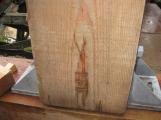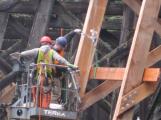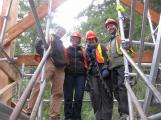14
Identification code, hand chiseled into new timbers18 January 2011
Kinsol Trestle, Cowichan Valley, Vancouver Island, BC Canada
 Credits:
Credits:Shawnigan Lake Historical Society
15
In 2004-2005, when a replacement version of the bridge was proposed to the CVRD, there was a real threat that the original bridge would be demolished. Had this approach been adopted, the loss of original historic material would have made the Kinsol Trestle ineligible for historic designation. Previous efforts by others to petition for designation would have been for naught. Gordon Macdonald discusses his motivations for presenting an alternative approach to a new bridge:AUDIO: Gordon Macdonald
I guess my motivation was twofold: in the first instance, I saw that the proposed new bridge consisted of poor-quality timber that had been pressure-treated in order to make it durable. It's a bit of a hobby horse for me. I don't like specifying these sorts of chemical treatments, if possible, and the thought of putting, of removing all of the existing structure and then putting a new structure back in its place - which was going to use a fantastic amount of wood, and chemically treated timber - just seemed environmentally, really quite nonsensical. So, that was the first motivation was, if nothing else, to recommend a kind of treatment that was more sustainable than the one that had been proposed - which is pretty outdated. In fact the form of treatment that had been proposed is a form banned in Europe, and we're probably heading that way ourselves. The second reason I was interested was I looked at some of the initial inspections and studies that had been done and it was really clear that they had all been done from a peculiar, or the particular, perspective of, was the bridge fit or not fit, could it be repaired to the standards of a working railway bridge or highway bridge. Nobody was really looking all that carefully at whether or not it could be repaired. Let me say that again in a different way. All of the previous studies had viewed the bridge from the perspective of, if there's something wrong with it, it should be replaced, therefore a partially decayed element should just be replaced, and as you can imagine, with all of these long and big timbers in the bridge, if you take that view, you end up with an enormous tally of material that has to be replaced. No one had been looking at in terms of repair, and particularly from the perspective of repairs that are common in the heritage world, but maybe less available to people who are working for railway companies and bridge companies, day by day.
Gordon described the dangers posed by not only the absence of any repairs made to the bridge in the previous twenty-five years, but also the decay that set in after long-term exposure to overgrown vegetation. He also considered the importance of retaining those aesthetic characteristics that make the bridge so appealing:
AUDIO: Gordon Macdonald
So the bridge went downhill in a hurry once that rot started to take hold. So all of the people who had been going out there to look at it had been looking at it through this funny lens of, if something is damaged then it surely needs to be replaced, because that's the way that the railwaymen treated the bridge themselves because they have to carry trains. What we were looking at was, with a slightly different value, we said, we sort of approached it by thinking, the bridge itself is quite beautiful in its precarious, decayed form. It is actually quite attractive as well, I don't mean for that to sound silly, it's just that the lovely patina of the old wood is what should be saved, not viewed as a negative. So we tried to look at innovative ways to repair the bridge and initially from the perspective of working our way bent to bent to bent across the bridge, making repairs from one end to the other. And then also we considered the new loading because obviously it's being used as a pedestrian bridge now...rather than carrying trains, so you can apply different criteria.
Ultimately, a conservation approach to repairing and rehabilitating the Kinsol Trestle was adopted by the CVRD.
16
Gordon Macdonald discusses past proposals regarding Trestle26 November 2010
Kinsol Trestle, Cowichan Valley, Vancouver Island, BC Canada
 Credits:
Credits:Gordon Macdonald, Speaker
Cowichan Valley Museum and Archives
17
Men working on active bent about 120 feet above river18 January 2011
Kinsol Trestle, Cowichan Valley, Vancouver Island, BC Canada
 Credits:
Credits:Shawnigan Lake Historical Society
18
Gordon Macdonald considers importance of retaining aesthetic characteristics26 November 2010
Kinsol Trestle, Cowichan Valley, Vancouver Island, BC Canada
 Credits:
Credits:Gordon Macdonald, Speaker
Cowichan Valley Museum and Archives
19
Visit to rehabilitation site18 January 2011
Kinsol Trestle, Cowichan Valley, Vancouver Island, BC Canada
 Credits:
Credits:Shawnigan Lake Historical Society
20
Access has been made available to the public throughout the duration of the project, providing visitors with a fascinating view of a monumental heritage conservation project. Since the rehabilitation began, the site has been visited by many people. Dave O'Laney, who has guided many visitors through the story of the rehabilitation project, observes,AUDIO: Dave O'Laney
People are amazed by the project, it's jaw-dropping once you're out there - the size of everything - and the challenges that we face, it's interesting. That's why I love when visitors do come, or I do a tour for the guests who are coming up to the bridge, because every single person has the same reaction, and that is such a positive reaction to the enormity of the project...there's no getting around the fact that a) this is a huge, huge project and b) it's a very special project, it's very unique in so many different ways.
21
Dave O'Laney talks about visitors to Trestle20 January 2011
Kinsol Trestle, Cowichan Valley, Vancouver Island, BC Canada
 Credits:
Credits:Dave O'Laney, Speaker
Cowichan Valley Musuem & Archives